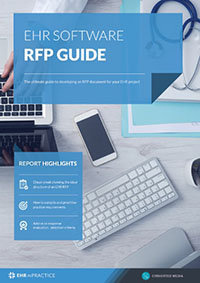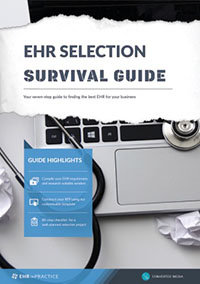Producing an EHR RFP: financial expectations
Having outlined your practice processes and requirements, you must also communicate financial expectations in your EHR RFP. These expectations must be clear to both the EHR vendor and practice administrators.
When seeking out proposals for your EHR selection project, it is important to consider funding along the way. It is easy to think that until the system is up and running, the process should not cost the practice anything besides time. However, this is not the case. Just as your practice will dedicate many hours to the process of selecting and analyzing EHR systems, your vendor will also commit many hours to your practice, once selected. Even before being chosen, the vendor will commit time to analyzing your RFP, creating a proposal for your company, and then in providing a software demonstration to your team.
Minimizing risk
Outlining financial expectations is important in order to minimize selection risk for your practice. In addition, this section of your EHR RFP will minimize risk for the vendor. The right vendor will commit many hours to demonstrate, train, evaluate and support onboarding of the new system. Because of the high level of support required, it is important both parties understand the levels of compensation expected during this intense period of training. If this is clearly outlined, then both parties can focus on implementation without any financial conflicts.
In response to your EHR RFP, vendors should outline when they expect to be paid during each stage of implementation as well as during ongoing use of the EHR system. Having financial targets (including EHR incentive targets) brings clarity to all parties. Your practice will need to know if there are any additional charges for customer support, or if there is a limit to clinician support and training. Your practice will also need a clear indication of the timeline of payment, as there will be a high amount of outgoing funds during a time when incoming resources may be limited due to a change in documentation/billing systems.
Financial target planning
You should have a general indication of your expectations for service, onboarding, training and implementation, but you must also list all terms of payment for satisfactory performance to ensure meaningful use is achieved. Create an evaluation tool to determine if your vendor has met your required expectations. Be clear with your expectations and share them with your vendor. Outline red flags for inadequate performance or non-compliance to the outlined contract.
A clear financial target plan within your EHR RFP will help reduce financial surprises for both your practice and your EHR vendor.
A clear financial target plan within your EHR RFP will help reduce financial surprises for both your practice and your EHR vendor. Most importantly, your practice will be able to better prepare their budget and allocate funding to handle the transition to the new EHR system.
Free white paper

EHR Software RFP Guide
Ensure your EHR RFP document will get the responses you want from vendors

Free white paper

EHR Software RFP Guide
Ensure your EHR RFP document will get the responses you want from vendors

Featured white papers
-

EHR Pricing Guide
Get your complete guide to EHR software pricing and project costs. Your headstart on EHR pricing research
Download -

EHR Selection Survival Guide
The comprehensive guide to selecting the best EHR system for your medical practice.
Download -

EHR Software RFP Guide
Ensure your EHR RFP document will get the responses you want from vendors
Download
Related articles
-

10 hidden costs of EHR software
Find out more about some of the hidden EHR costs that can render your budget and ROI forecasts nu...
-

Watch out for these red flags from your EHR RFP responses
Take note of these warning signs from your EHR vendor
-

Key benefits of EHR RFPs
How an RFP can provide an advantage for your organization during EHR selection

